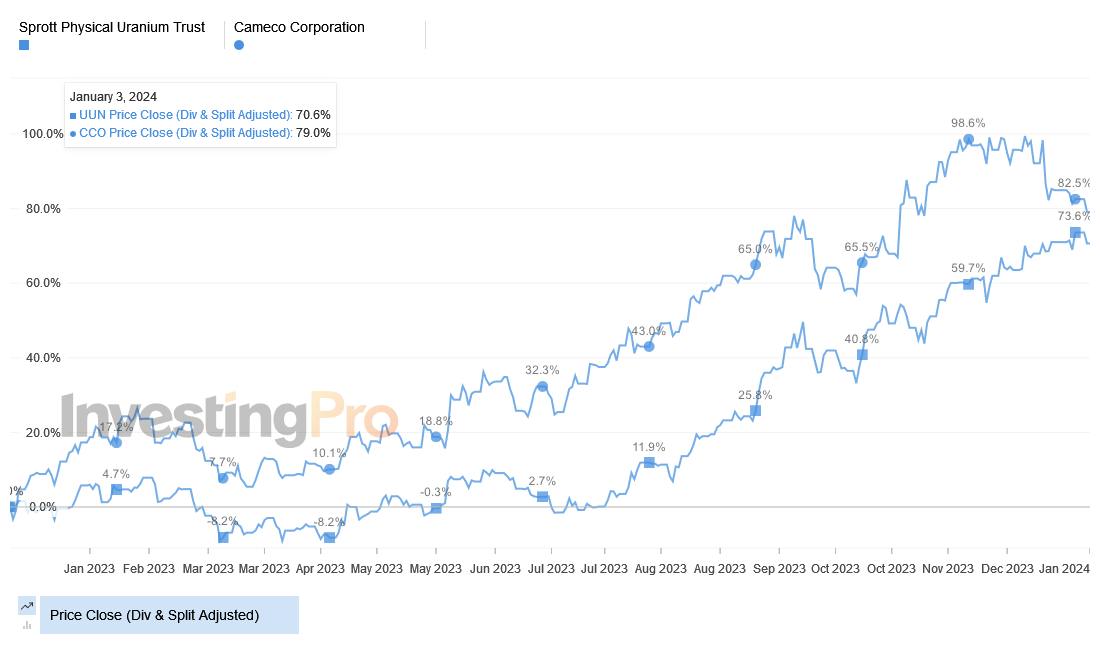The allure of investing in commodities traditionally draws investors towards the gleaming appeal of gold and silver. Some hardcore enthusiasts, referred to as goldbugs and silverbugs, even go to the extent of physically storing these precious metals in private safes.
However, when it comes to uranium, a markedly different approach is necessary. Due to its radioactive nature, physically holding uranium isn't just impractical; it's deadly and could result in a visit from a hazmat team.
Despite these challenges, there are viable ways for retail investors to engage with the growth potential of uranium and the broader nuclear energy sector, which has some tailwinds at play.
Notably, the World Nuclear Organization reports that a significant portion of the world's uranium production comes from mines in Kazakhstan, Canada, and Australia, with these mines supplying about 90% of what power utilities need.
Investors must however proceed with caution. The uranium market has experienced substantial price movements recently. For instance, Cameco (TSX:CCO), a leading Canadian uranium producer, saw its stock price surge by approximately 76% in 2023.
Similarly, the Sprott Physical Uranium Trust, a closed-end fund specializing in uranium, recorded a 72% increase in the same period. Such significant gains highlight the sector's volatility and the risk of entering the market at a potential peak.

As with any investment, especially in a sector as fluctuating as materials, it's vital to be aware of the market dynamics and consider the timing of your investment carefully.
With that in mind, here's a look at four of the leading ETFs investors can use to gain uranium exposure in their portfolios, based on the ETF Central screener.
Global X Uranium ETF (URA)
URA currently stands as the largest uranium-themed ETF, boasting $2.4 billion in assets under management (AUM). It tracks the Solactive Global Uranium & Nuclear Components Total Return Index and currently includes 46 holdings.
URA provides significant exposure to key players in the industry. Notably, it allocates about 23% of its weight to Cameco, one of the largest uranium producers. Additionally, the ETF has a 12% exposure to the Sprott Physical Uranium Trust, offering a unique angle on uranium investment.
Beyond mining companies, URA also encompasses nuclear energy utilities, reflecting the broader nuclear energy sector. Furthermore, the ETF has a substantial international presence, with notable exposure to markets in Australia and Kazakhstan, both of which are significant contributors to the global nuclear industry.
One interesting aspect of URA is its current negative 30-day SEC yield of -0.58%. This situation occurs when the expenses of the ETF exceed its income, leading to a negative yield. This can happen in thematic ETFs where the focus on specific sectors or themes might result in higher operational costs or lower income returns in certain market conditions.
Investors should note that URA comes with an expense ratio of 0.69%. While this is on the higher side, it is relatively common for thematic ETFs, which often incur additional costs due to their specialized focus and sometimes more illiquid holdings.
Sprott Uranium Miners ETF (URNM)
URNM is another notable option for investors looking to tap into the uranium market, particularly focusing on the mining aspect. This ETF complements Sprott's closed-ended physical uranium fund by offering a miner-centric approach.
URNM tracks the North Shore Global Uranium Mining Index, which is specifically designed to include companies with at least 50% of their business activities in uranium mining.
This encompasses exploration, development, production, holding, royalties, as well as support services and equipment. Essentially, URNM provides integrated access to the entire uranium mining ecosystem.
Since its launch in December 2019, URNM has attracted $1.7 billion in AUM spread across 37 holdings. Similar to URA, Cameco and the Sprott Physical Uranium Trust are significant components of URNM, each representing about 14% of the ETF’s weight.
However, a distinctive feature of URNM is its substantial allocation to NAC Kazatomprom (LON:KAPq) JSC, a Kazakhstan-based company, which makes up 15% of the ETF.
One consideration for potential investors is URNM's expense ratio, which stands at 0.83%. This is relatively high, reflecting the specialized nature of the fund and the niche market it targets.
For those seeking exposure to emerging players in the uranium sector, Sprott also offers the Sprott Junior Uranium Miners ETF (URNJ). As the name suggests, URNJ focuses on small-cap, up-and-coming companies in the uranium mining industry.
VanEck Uranium + Nuclear Energy ETF (NYSE:XLE) (NLR)
Another option for investors to watch is NLR, which offers a unique approach in the uranium and nuclear energy ETF space.
Unlike funds that focus solely on uranium mining, NLR also targets companies involved in constructing, designing, or maintaining nuclear electric utilities, as well as those that are utilities themselves, or provide technology, equipment, and services to the sector.
NLR achieves this broader focus by tracking the MVIS Global Uranium & Nuclear Energy Index. This index requires that companies generate a minimum of 50% of their revenues from nuclear energy-related activities to be included.
This criterion ensures that the ETF is not just a play on uranium prices and mining but also captures the broader alternative energy production sector.
The result is a portfolio that is markedly different from pure-play uranium mining ETFs. While NLR still includes miners like NAC Kazatomprom, Cameco, NexGen, and Paladin, its top holdings diverge significantly.
In the top three are companies like PG&E, Public Service Enterprise Group (NYSE:PEG), and Constellation Energy Corp. These utility companies add a different dimension to the ETF, reflecting the operational side of the nuclear energy industry.
The inclusion of utilities in NLR's portfolio not only diversifies its holdings but also contributes to reduced volatility compared to pure mining-focused ETFs. Additionally, NLR boasts a higher 30-day SEC yield of 1.78% due to their inclusion.
Finally, another appealing aspect of NLR is its cost. With an expense ratio of 0.67%, it is the most affordable option among the ETFs discussed.
This content was originally published by our partners at ETF Central.
